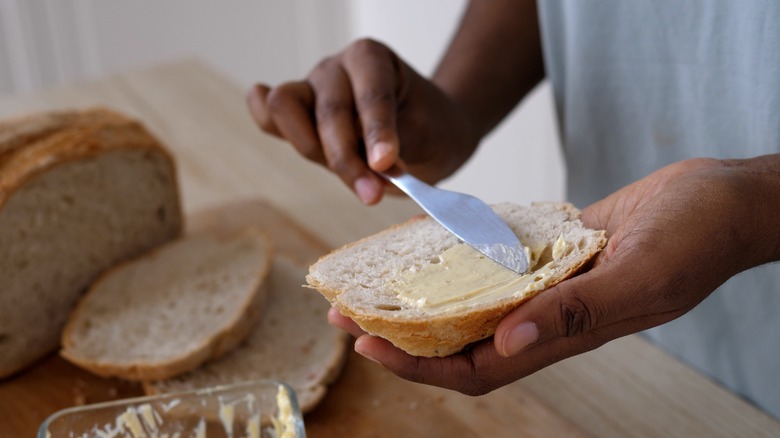Don't Count Out Your Body Heat For Softening Butter In A Pinch
We've all been there before — you're getting ready to add butter to your toast or use it in your recipe, only to find that it's a solid chunk. If you're struggling to spread or mix your cold butter, then you may be looking for a convenient way to warm it up. A popular TikTok hack suggests using your body heat to soften butter in a pinch.
In an online video, one TikToker demonstrated how to perform the hack, placing a fully wrapped stick of butter in the waistline of their jeans. The TikToker touted the convenience of the hack, pointing out that you can perform other tasks while waiting for your butter to soften, which they estimated would take around 10 minutes. While you could always leave your stick of butter out to soften at room temperature, it can take close to an hour to finally soften, which is less than ideal if you want to get dinner done quickly.
Butter starts to melt between 82 and 97 degrees Fahrenheit and the human body has an internal temperature of between 97 and 99 degrees Fahrenheit so butter should easily soften from body heat alone. While it does work, however, you should consider if this hack is really right for you.
There's real potential for germs
While the butter is fully wrapped for this softening hack, you may get more than a few troubled glances from your dinner guests if you use this method. No one wants to eat butter after it's been shoved halfway down your trousers. Likewise, if the butter softens too much and begins to melt, then you will have butter dripping down your leg, ruining your clothes. While you could use the body heat from your hands, that means you will be holding a stick of butter for several minutes.
All that is to say that while this hack is fun, it's probably not the best to incorporate into your cooking for more than a gag. There's a real risk of potential food contamination, which can cause foodborne illnesses. It's one of the reasons that the U.S. Department of Health & Human Services always recommends washing one's hands before handling any food in the kitchen. According to the National Institutes of Health, your skin is home to a thriving ecosystem of microbes and bacteria. While many of these bacteria can be considered good, meaning they lack the potential to make us sick and may even prevent harmful bacteria, that's not always the case. Skin contains bacteria that can also be harmful and make people sick as well. Is that really worth it for soft butter?
Try other ways to soften butter instead
While warming butter in your pants may make a statement about your creativity, there are more practical ways to soften butter that are also faster. For one, you shouldn't underestimate the humble microwave. Heating butter for around 15 seconds on a lower setting will soften the butter without causing it to melt everywhere. You can also use indirect heat to soften your butter by placing it near the stove while you cook or even softening it in a double boiler. Within minutes, your butter should begin to soften, but you'll have to remove it quickly before it starts to melt.
To speed up the time it takes butter to soften at room temperature without the risk of it melting, try slicing or grating it into smaller pieces or even rolling it out with a rolling pin. Both of these methods increase the surface area of the butter, allowing it to soften more quickly. In fact, sliced butter takes only around 10 minutes to soften at room temperature — the same as using body heat — while the rolling pin method is even faster.


